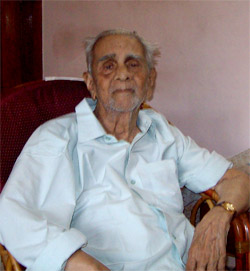Return to Kottakkal
A recent visit to my birthplace, Kottakkal, after a gap of 22 years, triggered in me a strong urge to dive deep into my family history.
I visited Kottakkal to attend a family reunion. The place had changed beyond recognition and to my family, I too had. Our annual get-togethers started six years ago and have done much to bring together a family, which the Hindu reported, has 250 members.. Together with spouse and children of male members, who are not family members in a matriarchal community, the number in the extended family goes up to 450. About 250 turn up. Only five families now live in Kottakkal and the burden of organizing the day long meet, with breakfast, lunch, introductions and a cultural programme, is cheerfully borne by them.
The eldest male member and the eldest female member together inaugurate the function. Although I was the second oldest among the attendees, I was given the honour of lighting the lamp and the duty of giving a speech in Malayalam- for the first time in my life. The Managing Trustee of our Family Trust, Vijayan. introduced me as a long lost brother and said, touchingly, “You have heard about him. Now you know that he exists in flesh and blood “. I spoke of my own urge to go back to my roots, and of the need to piece together the remnants of recorded history about our family. I realised that some of the younger members were already doing that.
Stanley Wolpert
I then remembered a meeting I had way back in 1988 with Prof Stanley Wolpert at the University of California, Berkeley. My Indian host had requested Stanley to take me round the University. After a brief introduction, Stanley asked me ‘ Raja, From where in India? ‘‘Calicut’ I said. ‘Raja! Calicut! Are you from the Zamorins?’ He then started giving me little facts about the family, from Vasco da Gama who landed in Calicut, about the same time as Christopher Columbus landed in America. Late in the evening, as I was about to leave, he said, he would like to take me home. And to, his wife, Dorothy, he said with unconcealed pleasure “I have met a Zamorin today!”
I had to correct him. The oldest member alone is the Zamorin and the Zamorin of that year was well over 85.
The present Zamorin, P K S Raja, whose picture I took last year, crossed 97 in March 2010.
Stanley Wolpert has written several books on India and certainly knew more than I and, I suspect, many other members about the early beginnings of our family.
Manavedan Raja
Every year we remember with gratitude the contribution of one outstanding achiever of the family. This year, the family had decided to honour the memory of Manavedan Raja (1855-1937). Apart from his achievements and sheer strength of character, Manavedan Raja is remembered for some ‘firsts’ in the family: the first, along with another younger member, to learn English, from an English teacher brought specially from Kumbhakonam by the Head of the Family; the first to earn a graduate degree from a University; the first member to enter government service and to become in 1890’s a District Collector and then a Judge.
In 1932 at the age of 77, Manavedan Raja became the Zamorin, the eldest member of the family-eldest among the Kottakkal branch and two other branches in Calicut. He took keen interest in the administration of Zamorins College, at Calicut and tried to refurbish its image.
In the 1930’s there were intense campaigns all over Kerala against untouchability and one such campaign was an indefinite fast in 1934 by the Gandhian, K Kelappan for the opening of the Guruvayoor temple to all castes. As Zamorin, Manavedan Raja was also the Chief Administrator of the Guruvayoor Temple. Mahatma Gandhi himself came down and during his visit, met Manavedan Raja. We do not know what happened at this meeting because neither of them spoke about it. One infers that they parted with the belief that nothing would change for the time being as the Chief Administrator was not the sole decision maker and certainly could not take a decision which could have explosive political and social consequences. Subsequently Gandhiji advised Kelappan to call off the fast.
Having benefited from a liberal education, Manavedan Raja wanted the family to follow suit. He started the Raja’s High School at Kottakal, created an endowment from own contributions, and did much to develop the Zamorins College at Calicut (now known as Guruvayoorappan College). His sons were well educated. The eldest became a District Collector and the second the Principal of an agricultural college. The fourth son, MK Vellodi joined the Indian Civil service, a very difficult accomplishment for an Indian in the 20’s. He was the first High Commissioner of independent India in the UK and later worked with Sardar Patel and VP Menon in the integration of princely states with the Indian Union. Vellodi rose to the position of Cabinet Secretary, the highest that a Civil Servant could have reached.
I believe such reunions of families are now becoming popular in Kerala. Members scattered all over the country and even abroad get to meet and revive connections. We stumble upon little known facts and bend to recover records which may otherwise go into history’s dustbins.





















Join my Network